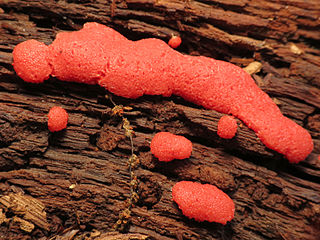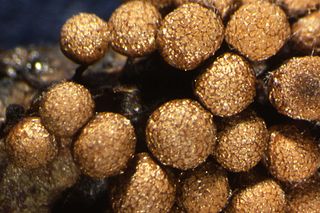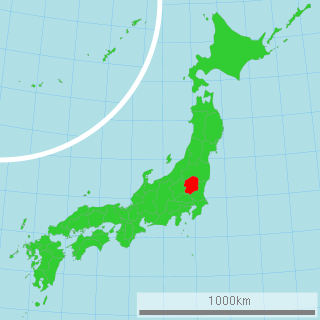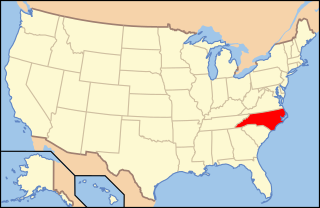Related Research Articles

Slime mold or slime mould is an informal name given to a polyphyletic assemblage of unrelated eukaryotic organisms in the Stramenopiles, Rhizaria, Discoba, Amoebozoa and Holomycota clades. Most are microscopic; those in the Myxogastria form larger plasmodial slime molds visible to the naked eye. The slime mold life cycle includes a free-living single-celled stage and the formation of spores. Spores are often produced in macroscopic multicellular or multinucleate fruiting bodies that may be formed through aggregation or fusion; aggregation is driven by chemical signals called acrasins. Slime molds contribute to the decomposition of dead vegetation; some are parasitic.

Myxogastria/Myxogastrea or Myxomycetes (ICN) is a class of slime molds that contains 5 orders, 14 families, 62 genera, and 888 species. They are colloquially known as the plasmodial or acellular slime moulds.

Trichiales is an order of slime moulds in the phylum Amoebozoa. Trichiales is one of five orders in the group Myxomycetes, or the true plasmodial slime molds. It is also currently categorized under the superorder Lucisporidia with its sister group, Liceales. The order was first described by Thomas MacBride in 1922, and has retained the same name and status as a defined order in present phylogeny. In the plasmodium form, members of Trichiales lack a columella but have a well-developed capillitium for spore dispersal. The shape and details of the capillitium are used to define families within the order. Spores are brightly coloured, ranging from clear, white and yellow to pink and red-brown tones. The order currently has 4 families, 14 genera and 174 species. Recent molecular research has shown that while Trichiales probably represents a true taxonomic group, its sister group Liceales is likely paraphyletic, and it has been suggested that several genera from the Liceales should be reclassified under Trichiales instead.

Tubifera is a genus of slime moulds from the subclass Myxogastria. The genus comprises 12 species.

Cribraria is a genus of slime molds from the group of Myxogastria. It comprises about 30 species, some of which are extremely difficult to distinguish.
Geasteroides is a fungal genus in the family Geastraceae. A monotypic genus, it contains the single species Geasteroides texensis, described by American mycologist William Henry Long in 1917.

Aseroe coccinea is a species of stinkhorn fungus in the genus Aseroe. First reported in Japan in 1989, it was not formally validated as a species until 2007, the delay related to a publication error. The receptacle, or fruit body, begins as a partially buried whitish egg-shaped structure, which bursts open as a hollow white stipe with reddish arms, then erupts and grows to a height of up to 15 mm (0.6 in). It matures into a star-shaped structure with seven to nine thin reddish tubular "arms" up to 10 mm (0.4 in) long radiating from the central area. The top of the receptacle is covered with dark olive-brown spore-slime, or gleba. A. coccinea can be distinguished from the more common species A. rubra by differences in the color of the receptacle, and in the structure of the arms. The edibility of the fungus has not been reported.

Gottlob Ludwig Rabenhorst was a German botanist and mycologist.

Brefeldia maxima is a species of non-parasitic plasmodial slime mold, and a member of the class Myxomycetes. It is commonly known as the tapioca slime mold because of its peculiar pure white, tapioca pudding-like appearance. A common species with a worldwide distribution, particularly in North America and Europe. It is often found on bark after heavy rain or excessive watering. Their spores are produced on or in aerial sporangia and are spread by wind, however beetles of the family Latridiidae are also reported to disperse the spores. Bonner states that soil invertebrates and rain mainly disperse spores as they are sticky and unlikely to be carried by air currents.

Paraphaeosphaeria pilleata is a species of fungus in the Lophiostomataceae family. The species fruits exclusively in the lower parts of the culms of the black needlerush. It is found on the Atlantic Coast of North Carolina.

Willkommlangea reticulata is a slime mold species from the order Physarales and the only species of the genus Willkommlangea. It is common worldwide, but rare in Europe. The tropics are possibly the main area of habitat.

Trichia decipiens is a worldwide widespread slime mould species from the order Trichiida.
Prototrichia metallica is a slime mould species from the order Trichiida and the only species from the genus Prototrichia. It is mainly distributed on mountains.
Physarum aeneum is a slime mould species from the order Physarida. It is one of a few slime moulds mainly common in the tropics and subtropics.

Lindbladia tubulina is a slime mould species from the order Liceida and the only member of its genus.
Barbeyella minutissima is a slime mould species of the order Echinosteliales, and the only species of the genus Barbeyella. First described in 1914 from the Jura mountains, its habitat is restricted to montane spruce and spruce-fir forests of the Northern Hemisphere, where it has been recorded from Asia, Europe, and North America. It typically colonises slimy, algae-covered logs that have lost their bark and have been partially to completely covered by liverworts. The sporangia are roughly spherical, up to 0.2 mm in diameter, and supported by a thin stalk up to 0.7 mm tall. After the spores have developed, the walls of the sporangia split open into lobes. The species is one of the smallest members of the Myxogastria and is considered rare.

Calostoma cinnabarinum, commonly known as the stalked puffball-in-aspic,gelatinous stalked-puffball, or red slimy-stalked puffball, is a species of gasteroid fungus in the family Sclerodermataceae, and is the type species of the genus Calostoma. The fruit body has a distinctive color and overall appearance, featuring a layer of yellowish jelly surrounding a bright red, spherical head approximately 2 centimeters (0.8 in) in diameter atop a red or yellowish brown spongy stipe 1.5 to 4 cm tall. The innermost layer of the head is the gleba, containing clear or slightly yellowish elliptical spores, measuring 14–20 micrometers (μm) long by 6–9 μm across. The spore surface features a pattern of small pits, producing a net-like appearance. A widely distributed species, it grows naturally in eastern North America, Central America, northeastern South America, and East Asia. C. cinnabarinum grows on the ground in deciduous forests, where it forms mycorrhizal associations with oaks.

Arthur Hugh Lister (1830–1908) was a wine merchant and botanist, known for his research on Mycetozoa also known as slime molds.

Trichia crateriformis is a slime mold species in the order Trichiida found in temperate areas throughout the world.
Eduard Adolf Wilhelm Jahn was a German biologist and mycologist.
References
- 1 2 3 Thomas H. Macbride, G. W. Martin: The Myxomycetes; a descriptive list of the known species with special reference to those occurring in North America, p. 248, New York, 1934
- 1 2 3 (in German) Hans Schinz: Myxogasteres (Myxomycetes, Mycetozoa) In: Dr. L. Rabenhorst's Kryptogamen-Flora von Deutschland, Oesterreich und der Schweiz, volume.1 (Die Pilze Deutschlands, Oesterreichs u. d. Schweiz mit Berücksichtigung der übrigen Lander Europas), 10th edition, pp. 408-410, 1920
- 1 2 B. Ing: Notes on Myxomycetes II. In: Transactions of the British Mycological Society 50(4), p. 559, 1967
- ↑ (in German) botanischestaatssammlung.de: The Myxomycetes Collections at the Botanische Staatssammlung München , retrieved on 8 August 2010
- ↑ botanischestaatssammlung.de: The Myxomycetes Collections at the Botanische Staatssammlung München , retrieved on 8 August 2010
- 1 2 Donald T. Kowalski: Observations on the Dianemaceae In: Mycologia, volume.59:6, pp. 1075-1084, 1967
- ↑ Michael J. Dykstra, Harold W. Keller: Mycetozoa In: An illustrated guide to the protozoa : organisms traditionally referred to as protozoa, or newly discovered groups, Society of Protozoologists, p. 962, 2000
- ↑ Burkhardt, Lotte (2022). Eine Enzyklopädie zu eponymischen Pflanzennamen [Encyclopedia of eponymic plant names](pdf) (in German). Berlin: Botanic Garden and Botanical Museum, Freie Universität Berlin. doi:10.3372/epolist2022. ISBN 978-3-946292-41-8 . Retrieved January 27, 2022.